Coins of the United States dollar, aside from those of the earlier Continental currency were first minted in 1792. New coins have been produced annually and they make up a valuable aspect of the United States currency system. Circulating coins exist in denominations of 1¢, 5¢, 10¢, 25¢, 50¢, and $1.00. Also minted are bullion, including gold, silver and platinum, and commemorative coins. All of these are produced by the United States Mint. The coins are then sold to Federal Reserve Banks which in turn are responsible for putting coins into circulation and withdrawing them as demanded by the country's economy.
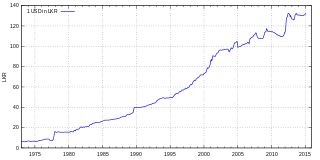
The Sri Lankan Rupee is the currency of Sri Lanka. It is subdivided into 100 cents (සත), but cents are rarely seen in circulation due to its low value. It is issued by the Central Bank of Sri Lanka. The abbreviation Re (singular) and Rs (plural) is generally used, the World Bank suggests SL Rs as a fully disambiguating abbreviation for distinction from other currencies named "rupee".

The lira was the currency of Italy between 1861 and 2002. It was introduced by the Napoleonic Kingdom of Italy in 1807 at par with the French franc, and was subsequently adopted by the different states that would eventually form the Kingdom of Italy in 1861. It was subdivided into 100 centesimi, which means "hundredths" or "cents". The lira was also the currency of the Albanian Kingdom from 1941 to 1943.

The pound was the currency of Australia from 1910 until 14 February 1966, when it was replaced by the Australian dollar. Like other £sd currencies, it was subdivided into 20 shillings, each of 12 pence.
The pound is the currency of Guernsey. Since 1921, Guernsey has been in currency union with the United Kingdom and the Guernsey pound is not a separate currency but is a local issue of sterling banknotes and coins, in a similar way to the banknotes issued in Scotland, England and Northern Ireland. It can be exchanged at par with other sterling coinage and notes.
The Bermudian dollar is the official currency of the British Overseas Territory of Bermuda. It is subdivided into 100 cents. The Bermudian dollar is not normally traded outside Bermuda, and is pegged to the United States dollar at a one-to-one ratio. Both currencies circulate in Bermuda on an equal basis.

The Trinidad and Tobago dollar is the currency of Trinidad and Tobago. It is normally abbreviated with the dollar sign $, or alternatively TT$ to distinguish it from other dollar-denominated currencies. It is subdivided into 100 cents. Cents are abbreviated with the cent sign ¢, or TT¢ to distinguish from other currencies that use cents. Its predecessor currencies are the Trinidadian dollar and the Tobagonian dollar.
The Solomon Islands dollar is the currency of Solomon Islands since 1977. Its symbol is $, with SI$ used to differentiate it from other currencies also using the dollar sign. It is subdivided into 100 cents.
The Tuvaluan dollar is one of the currencies of Tuvalu, whose unofficial international currency code is TVD. Tuvalu has never had banknotes of its own, and has been issuing coins since 1976. However, the Tuvaluan dollar is used as a unit of account, and is pegged to the Australian dollar at parity. From 1966 to 1976, Tuvalu officially used the Australian dollar. In 1976, Tuvalu began issuing its own coins, which continue to circulate alongside Australian coins. Tuvalu continues to use Australian banknotes. Tuvaluan coins are not legal tender in Australia. Similar to the Faroese króna's relationship to the Danish krone and the Panamanian balboa's relationship to the United States dollar, the Tuvaluan dollar is not an independent currency, but a variation of the Australian dollar.
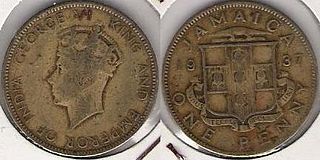
The pound was the official currency of Jamaica between 1840 and 1969. It circulated as a mixture of sterling coinage and locally issued coins and banknotes and was always equal to the pound sterling. The Jamaican pound was also used in the Cayman and Turks and Caicos Islands.

The Cook Islands dollar was the former currency of the Cook Islands, which now uses the New Zealand dollar, although some physical cash issued for the Cook Islands dollar remains in use. The dollar was subdivided into 100 cents, with some older 50-cent coins carrying the denomination as "50 tene".
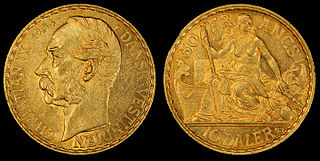
The daler was the currency of the Danish West Indies between 1849 and 1917, and of the United States Virgin Islands between 1917 and 1934.
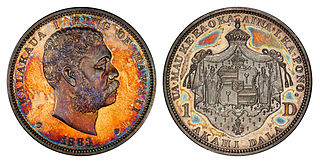
The dollar or dala was the currency of Hawaii between 1847 and 1898. It was equal to the United States dollar and was divided into 100 cents or keneta. Only sporadic issues were made, which circulated alongside United States currency.
The pound was the currency of Bermuda until 1970. It was equivalent to sterling, alongside which it circulated, and was similarly divided into 20 shillings each of 12 pence. Bermuda decimalised in 1970, replacing the pound with the Bermudian dollar at a rate of $1 = 8s.4d., equal to the US dollar.
The coins of the Australian dollar were introduced on 14 February 1966, although they did not at that time include the one-dollar or two-dollar coins. The dollar was equivalent in value to 10 shillings in the former currency.
The coins of the New Zealand dollar are used for the smallest physical currency available in New Zealand. The current denominations are ten cents, twenty cents, fifty cents, one dollar and two dollars. The $1 and $2 coins are minted in a gold colour, the 20c and 50c coins are silver colour and the 10c coin is plated in copper.

The first coins of the Indonesian rupiah were issued in 1951 and 1952, a year or so later than the first Indonesian rupiah banknotes printed, following the peace treaty with the Netherlands in November 1949. Although revolutionary currency had been issued by the provisional Indonesian government between 1945 and 1949, it had all been formed of paper, for metal were too scarce for the internationally isolated government to use as currency.
Niue, a country in free association with New Zealand, uses only one official legal tender currency, which is the New Zealand dollar.
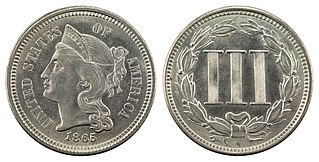
The copper-nickel three-cent piece, often called a three-cent nickel piece or three-cent nickel, was designed by US Mint Chief Engraver James B. Longacre and struck by the United States Bureau of the Mint from 1865 to 1889. It was initially popular, but its place in commerce was supplanted by the five-cent piece, or nickel.
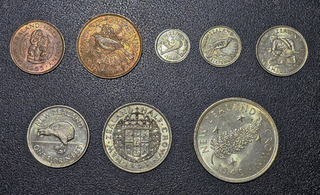
The first coinage of the New Zealand pound was introduced in 1933 in response to large-scale smuggling of prior British imperial coinage after devaluation of New Zealand exchange rates relative to the pound sterling and large influxes of other foreign coinage into circulation. The Coinage Act, 1933 outlined the weights and compositions of various denominations, out of which five silver issues entered circulation over the following year, after lengthy disagreement between rival coinage design committees. The copper penny and halfpenny entered circulation in 1940, corresponding to anniversary of the New Zealand centennial. An eighth denomination of coin, the five-shilling piece or crown, was produced solely through three commemorative issues. The first issue, the Waitangi crown, was produced in extremely limited quantities and sold to collectors. Later commemorative crown issues in 1949 and 1953 were produced for circulation.










